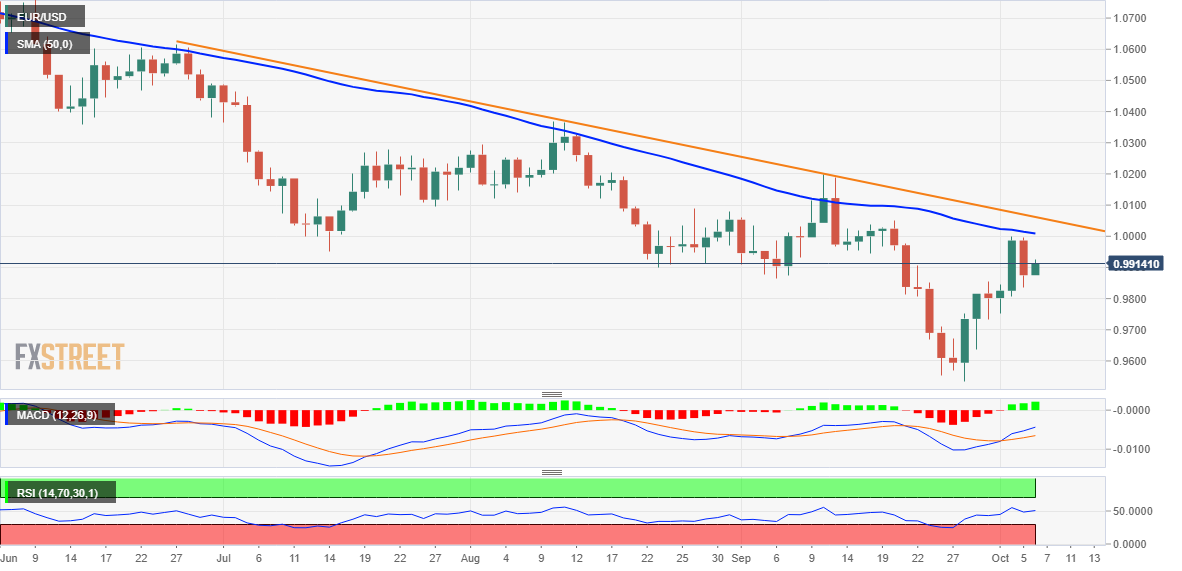- EUR/USD met with a fresh supply on Wednesday amid resurgent USD demand.
- Hawkish Fed expectations, rising US bond yields and risk-off lift the greenback.
- Geopolitical risk weighs on the euro and contributes to the sharp overnight fall.
The EUR/USD pair faced rejection near the parity mark and came under renewed selling pressure on Wednesday, reversing a significant part of the previous day's positive move to a two-week high. The US dollar made a solid comeback and stalled its recent sharp pullback from a two-decade high, which, in turn, was seen as a critical factor exerting downward pressure on the major. Fed officials reiterated the US central bank's commitment to controlling inflation and reaffirmed expectations for a more aggressive policy tightening. The markets have been pricing in the possibility of another supersized 75 bps Fed rate hike move in November. This, in turn, pushed the US Treasury bond yields higher and acted as a tailwind for the buck.
Furthermore, worries that rapidly rising borrowing costs will lead to a deeper global economic downturn continue to weigh on investors' sentiment. This led to a fresh leg down in the equity markets and was seen as another factor underpinning the safe-haven greenback. On the economic data front, the US ISM Services PMI came in slightly better than estimates and edged to 56.7 in September from 56.9 previous. From the Eurozone, the Services PMI was revised for September and the composite index was finalized at a 20-month low. This comes amid the risk of a further escalation in the Russia-Ukraine conflict, which weighed on the shared currency and further contributed to the EUR/USD pair's overnight steep decline of over 150 pips.
However, spot prices showed some resilience below the mid-0.9800s and rebounded a few pips from the daily low. The recovery momentum extends through the Asian session on Thursday and lifts the EUR/USD pair back above the 0.9900 round-figure mark. Market participants now look forward to the release of the ECB Monetary Policy Meeting Accounts for a fresh impetus. Later during the North American session, traders will take cues from the US Weekly Initial Jobless Claims data and speeches by FOMC members. The focus, however, remains on the closely-watched US employment details on Friday. The popularly known NFP report will influence Fed rate hike expectations, which will drive the USD demand and help determine the near-term trajectory for the major.
Technical Outlook
From a technical perspective, the EUR/USD pair stalls its recent recovery move from its lowest level since June 2002 near the parity mark. The said handle now coincides with the 50-day SMA and should now act as a pivotal point. A multi-month-old descending trend-line hurdle follows this, currently around the 1.0050 region, which if cleared decisively will suggest that spot prices have formed a bottom and pave the way for additional gains. The subsequent move-up should allow bulls to aim to reclaim the 1.0100 round figure and test the next relevant hurdle near the 1.0120 horizontal zone.
On the flip side, sustained weakness below the 0.9900 mark could drag the EUR/USD pair back towards the 0.9860-0.9850 region. Some follow-through selling below the overnight swing low, around the 0.9835 area, will be seen as a fresh trigger for bearish traders and prompt aggressive technical selling. Spot prices might then turn vulnerable to weaken further below the 0.9800 round-figure mark and accelerate the drop towards the 0.9750-0.9745 support zone.






